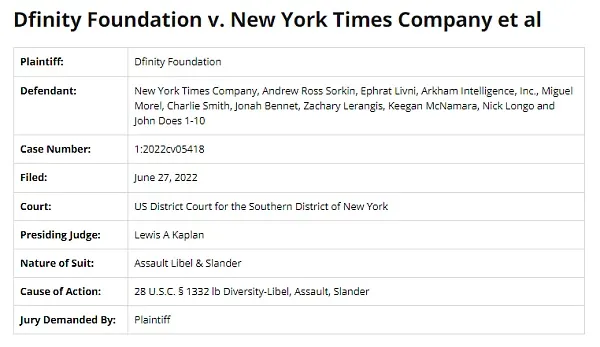The 10,000-word investigation into the mystery of ICP market manipulation: Who precisely targeted the flourishing DFINITY? (Arkham Edition)
Original: Crypto Leaks
Compiled by: Baize Research Institute
The original text comes from the investigative company Crypto Leaks, which exposes scandals in the crypto industry. The first two cases they reported were about the manipulation of ICP's price by capital and malicious short selling. In the SBF article, Crypto Leaks investigated the market suspicions and conditions at the time, believing that the ICP token was clearly manipulated before and after its listing. As the "spokesperson" for Solana, which was extremely popular in 2021, SBF had the motive and ability to destroy the largest competitor, the IC network (however, there is no substantial evidence, and there will not be any in the future).
This article is about Arkham, providing a wealth of video evidence indicating that Arkham received sponsorship and published a research report that deliberately smeared ICP. The DFINITY Foundation later cited this article to file a defamation lawsuit against Arkham and The New York Times. The publication date is June 9, 2022, with slight edits by the translator.
Summary of the article:
• Using spy dialogue videos and facts to examine the ICP report released by Arkham Intelligence in June 2021.
• The report focuses on the IC network launched by the DFINITY Foundation, with its native token named ICP.
• At that time, Arkham was just a rookie company with no record or obvious expertise related to crypto research.
• Their only publicly listed team member is founder Miguel Morel --- --- apart from his LinkedIn page claiming he is a cryptocurrency investor and helped create a cryptocurrency business called Reserve, we could not gather any information about him.
• The Arkham ICP report claims that when the DFINITY Foundation launched the IC network, insiders engaged in "pump and dump," which is the reason for the ICP price rising and then falling. However, they did not provide any substantial evidence.
• The report was published on Twitter, accompanied by a video produced in the style of a crime documentary.
• Due to its subjective content and lack of substantial content, the report should not have received any coverage, yet it mysteriously became associated with The New York Times. The New York Times turned the report into a "deadly weapon" against DFINITY's reputation.
• Arkham's founder Miguel claims that the report was not paid for.
• However, the spy videos we collected show that Arkham was commissioned to create a "defamatory" report against the ICP token, with the client possibly being a competitor of the IC network.
• The Arkham ICP report and The New York Times article were subsequently used as the basis for attacks against the DFINITY Foundation.
• After the report was published, the Arkham team relocated to a mansion in Chelsea, London, clearly having received substantial funding from somewhere. The video shows a security team guarding unidentified goods entering the mansion.
Investigation Background
The Internet Computer (IC) blockchain went live on May 10, 2021, developed by a large team from the DFINITY Foundation. There was great excitement before the official launch of IC, as the IC network was claimed to play the role of a "world computer," providing a decentralized alternative to traditional IT and supporting fully on-chain Web3 services, such as social networks.
After the mainnet launch, its native token ICP could be transferred on the network, and cryptocurrency exchanges around the world began to create spot markets where users could trade ICP tokens. In the initial hours after the mainnet launch, the price of the ICP token remained above $450, with a fully diluted market cap reaching $230 billion, which is an undisputed overvaluation. Then, the price began to fall.
By June 28, 2021, the price of ICP had dropped to $50, with a fully diluted market cap of $23.5 billion, which could be said to be comparable to other competing networks at the time.
Subsequently, a previously unknown research company --- --- Arkham Intelligence, led by the unknown founder and CEO Miguel Morel, released the "Arkham ICP Report."
The basic claim of the Arkham ICP report is that the DFINITY Foundation is the main contributor to the underlying technology of the IC network, and that relevant insiders somehow set a high initial price for the ICP token and engaged in "pump and dump" when the token was listed.
However, it is very unusual for an organization composed of hundreds of renowned computer science researchers, cryptographers, and engineers to spend years developing a blockchain network and then abandon its vision at the time of the mainnet launch. Furthermore, the report is filled with unverified claims, inaccuracies, and obvious logical fallacies. To any experienced observer in the cryptocurrency field, this looks very much like market manipulation aimed at damaging DFINITY's reputation, possibly sponsored by competitors of the IC network or financial participants looking to short its tokens.
The Arkham ICP report would not have received much attention, but evidently thanks to The New York Times columnist Andrew Ross Sorkin, the report was published simultaneously with an article in The New York Times and a Dealbook newsletter, both of which promoted the report. By providing credibility to the report, The New York Times caused significant damage to the reputation of the DFINITY Foundation and its leaders, as well as the IC ecosystem. It can be said that this led to a further devaluation of the ICP token's market cap by billions of dollars. It is unclear why The New York Times chose to promote the Arkham ICP report, which clearly did not merit being considered a credible source of information.
From all accounts, the DFINITY Foundation did not sell any ICP tokens within weeks after the mainnet launch. The project's founder Dom stated that he only sold a small portion of the tokens (only 5% of his holdings). Additionally, simple common sense tells us that if the market price of the ICP token was too high after the mainnet launch, it would naturally decline through normal price discovery, without the need for "insider dumping."

In this article, we explore the individuals and content behind the Arkham ICP report, as well as The New York Times' puzzling decision to promote the report. As we demonstrate through spy videos and other means, the deeper the investigation goes, the more perplexing The New York Times' actions appear.
Why Did The New York Times Support the Arkham ICP Report?
The New York Times published an article titled "The Dramatic Collapse of Cryptocurrency is Shocking," while simultaneously releasing "How the ICP's Proud ICO Collapsed" in the Dealbook newsletter, pushing it to subscribers. (Note: After this article was published, the DFINITY Foundation filed a defamation lawsuit against The New York Times and Arkham Intelligence, and The New York Times re-edited the title, removing the term "ICO.")
In "How the ICP's Proud ICO Collapsed," The New York Times referred to Arkham Intelligence as a credible "crypto analytics company" and promoted the Arkham ICP report, providing a link to the report. Meanwhile, although Arkham had not published any content prior, it also did not publish any other content for over a year (as of June 2022).
The New York Times' "How the ICP's Proud ICO Collapsed" repeatedly mischaracterized the IC network, which was experiencing its mainnet launch, as an "Initial Coin Offering," or "ICO" (involving an organization selling non-usable tokens to the public to raise funds for development, promising that this would make the tokens usable) --- --- something that regulators in many countries have long prohibited --- --- clearly intending to smear the DFINITY Foundation as engaging in illegal activities.
The basic premise of the article can be summarized by a statement made by Miguel Morel in a short video promoting the Arkham ICP report that he posted on Twitter. The video uses the "crime reveal" music commonly found in TV dramas as background music to express his claim --- --- that the DFINITY Foundation and insiders are "guilty":
"Our findings lead us to believe that DFINITY insiders have been continuously depositing and dumping billions of dollars worth of ICP tokens on exchanges, while others watch their investments shrink. If the available data in our analysis is accurate, we should propose that the ICP token may be one of the most extreme cases of investor abuse in the history of the cryptocurrency market and the entire financial market."
Miguel made explicit statements about the "crimes" of the DFINITY Foundation and insiders. Although Arkham Intelligence had only 200 followers on Twitter at the time of the release, due to The New York Times' promotion, this video from Arkham Intelligence had nearly 20,000 views by May 2022, and their "viewpoint" became well-known.
As we noted in the SBF article, the Arkham ICP report was likely created with the specific purpose of harming ICP, whether by competitors or market manipulators looking to short ICP. So why would The New York Times, with its distinguished history and mission to seek the truth for its readers, provide credibility and deserved reputation to Arkham?
From the moment our investigators began collecting spy videos and understanding what was happening, something started to feel off…
Investigating Arkham Intelligence
The name Arkham Intelligence seems to pay homage to Gotham Research, a well-known and respected financial research firm. However, we do not believe that The New York Times confused the two when deciding to promote Arkham as a credible "crypto analytics company." Arkham Intelligence has no prior record and has only publicly listed one employee, Miguel Morel, who also has no prior record.
Just discovering these two points has already raised serious red flags, and we found even more serious issues later.
Where Exactly is the Arkham Team?
They are registered in Delaware, established on March 4, 2021.

However, this establishment date does not match their Twitter account, which was created in May 2019, two years earlier, indicating that the account was renamed. Their first tweet appeared on June 28, 2021, the same day The New York Times published its article. This date also does not align with Miguel Morel's LinkedIn profile, which states he joined Arkham in January 2020. But these inconsistencies in dates are just the beginning.
However, for a short period after the ICP report was published, the Arkham team was still working at its headquarters in the countryside outside Austin, Texas, rather than in the kind of luxurious office building you would expect to find a respected research company:

But after the ICP report gained traction, this small team moved out of Texas. Perhaps they made a lot of money, as they relocated to a mansion in Chelsea, London. According to initial advertisements, the rent for this mansion is £32,500, or about $43,000 per month.

One might think that "crypto analytics" could be a simple business, but Arkham is registered in various states across the U.S.: Delaware, California, New York, and even Colorado.
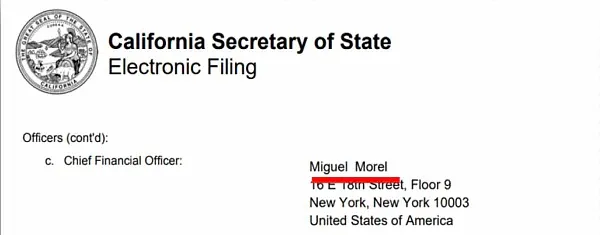
Arkham in Chelsea
Arkham's new headquarters in Chelsea, London, houses many Arkham team members or branches. Some new members include: Henry Fisher, head of the crypto project Reserve and current CTO of Arkham; Charlie Smith, former business development director of Reserve and co-founder of Arkham; Jonah Bennett, a journalist and co-founder of an online magazine that hired several Arkham employees as writers; Zachary Lerangis, current operations director of Arkham; and Keegan McNamara, former TPM of Arkham.
Three things are worth noting.
First, the people here are all in their early 20s.
Second, Charlie Smith and Keegan McNamara have since left Arkham to start new startups, reflecting the turnover of Arkham members and why it should not be viewed as a traditional company.
Third, three members are connected to a "stablecoin" project called Reserve, and Miguel also claims to be a co-founder of that project…
What is the Reserve Project?
Reserve is not a large tech project like the IC network. Its goal is to provide a "stablecoin" running on the Ethereum network. Investors can buy the stablecoin through its RSR token, which has dropped over 96.5% in value since its peak.
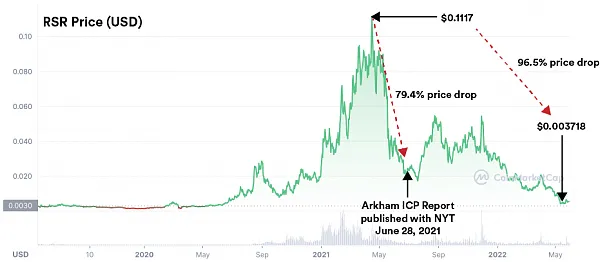
What crypto enthusiasts would want to see is a report written by thoroughly researched, fair, and objective professional researchers, not one written by cryptocurrency entrepreneurs, which could lead to biased and inaccurate conclusions. It is especially puzzling that their own token has sharply declined at the same time as the ICP token, but they presumably would not claim that its price drop was due to insider trading.
Due to the plummeting price of Bitcoin, many token prices fell in response, and this crash began almost the moment the IC mainnet went live. Between April 14, 2021, and July 20, 2021, BTC fell from $63,314 to $29,807. Its largest drop began on May 10, 2021, the same day the IC mainnet launched. However, the Arkham report completely disregarded the impact of BTC on the ICP price, even though this also caused their own RSR token to drop by 79.4%.
Even if they had direct experience of how the volatility in the crypto market affected token prices at that time, when Arkham created the ICP report, they mysteriously did not mention these market trends, instead choosing to weave a false narrative about the misconduct of DFINITY insiders, which is sufficient to prove that their actions were intentional.
Information About Miguel Morel
At the time of the ICP report's release, founder and CEO Miguel Morel was the only publicly listed Arkham employee. His LinkedIn profile revealed very little about his career history and qualifications. Given that his resume included a university logo, he appears to have graduated high school and attended university courses. Miguel claims to be a co-founder of Reserve, but shortly after the release of the Arkham ICP report, all information about Miguel was removed from Reserve's official website.
Although Reserve did not list Miguel as a co-founder when the Arkham ICP report was released, their website did contain a blog post attributed to Miguel Morel, which was quickly deleted.
While it is unclear what Miguel Morel meant when he claimed to be a "co-founder" of Reserve, this affiliation suggests he may have had pre-existing financial interests in cryptocurrency, which could make his claims far from fair and objective.
Clearly, when promoting a report that could cause billions of dollars in losses, Miguel should not be someone The New York Times could trust.
Was the Arkham ICP Report Sponsored?
The New York Times published their article and DealBook newsletter on June 28, 2021, promoting the Arkham ICP report. A few days later, as the IC ecosystem and ICP token were damaged, Miguel Morel posted his last tweet (at the time of writing), claiming he was not sponsored to write the report, had not received any form of compensation, and did not hold or short ICP:
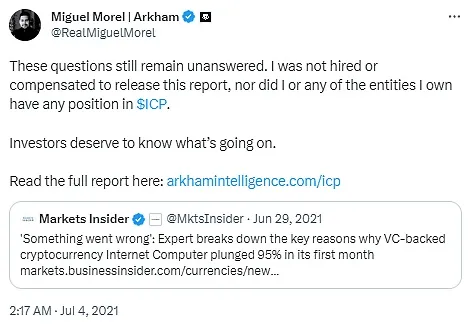
However, in one of the spy videos we collected, Arkham employee Nick Longo stated that he believed the client had paid for the report (interested readers can check the original text for the video, https://cryptoleaks.info/case-no-2).
Useful dialogue from the video:
Nick: This (the ICP report) was a good opportunity to get attention, so we published it. I remember a client paid for it.
Mystery person: (Paid) to investigate ICP?
Nick: ICP was the first, there are other crypto projects.
Johan Bennett was more straightforward about why Arkham created the ICP report.
Mystery person: What can Arkham gain from this?
Johan: They charge for the reports; they were hired to do this. That's how they make money.
Johan: I think they were specifically hired to do this; it definitely wasn't just chosen from so many blockchains. I think it was hired by dissatisfied users or investors.
Mystery person: In Arkham's case, can The New York Times' article generate income in some way? Or is it for mutual benefit?
Johan: No, I think they were just hired by a client to write it.
Video evidence suggests that the report was sponsored, with the aim of blaming the ICP price drop on the DFINITY Foundation and "insiders" involved in the ecosystem. The report casually grabbed some large ICP trades and claimed without other evidence that these trades were insiders dumping. The report never questioned why the initial price of ICP was so high, nor did it explain why a price that high would not naturally decline.
The report not only appears to have been created for paying clients, but its strong claims were made without a reasonable basis:
Nick: We did some investigations for clients, like ICP, basically inferring who owns these wallets, but these are just inferences… insiders sold all the tokens, and we didn't…
Mystery person: Evidence?
Nick: Yes.
Arkham's Investor is Tim Draper
Tim Draper is a well-known American billionaire with a large cryptocurrency investment portfolio. His investments in cryptocurrency began with a substantial holding of Bitcoin, later expanding to emerging projects like Ripple, BCH, Tezos, and Aragon. His son Adam Draper "inherits" his ambitions and holds a large amount of cryptocurrencies such as Bitcoin, Monero, and Ethereum through his venture capital fund Boost VC. For the Draper family, the IC network and the DFINITY Foundation may be seen as a direct threat to their family fortune, as the innovative IC network can be viewed as a direct competitor to all common blockchains.
Nick: Did we have some angel investors at that time?
Mystery person: Can you tell me their names?
Nick: Most importantly, Tim Draper.
Miguel Morel publicly claims that the Arkham ICP report was not sponsored and was made for the crypto community. However, it not only appears to have been commissioned by unknown parties for unknown reasons, but as Nick Longo reveals below, it was made using Tim Draper's funds:
Nick: When focusing on the ICP (report)… we raised a lot of money at that time, a Series A funding round, several million dollars, while we still had some money left from the original angel investors.
Suspicious Activities at Arkham's Chelsea Headquarters
After publishing the ICP report, the Arkham team moved from their rural residence in Texas to a mansion in Chelsea, but interesting things happened. Travel bags filled with goods arrived at the villa, containing unknown items. Miguel's briefcase was sometimes carried by security but always accompanied by security, who nervously checked back and forth on the road until it was delivered inside the house:
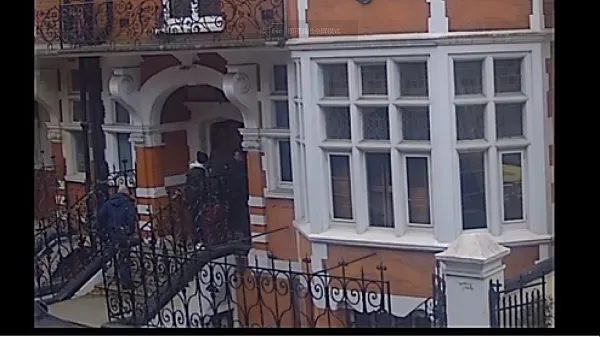


Arkham Caused Various Damages to the IC Ecosystem
We found that many parties involved believed Arkham's claims simply because The New York Times endorsed them, leading to direct attacks that harmed the IC ecosystem and exacerbated reputational damage. This extended to class action lawsuits, one of which is shown below:
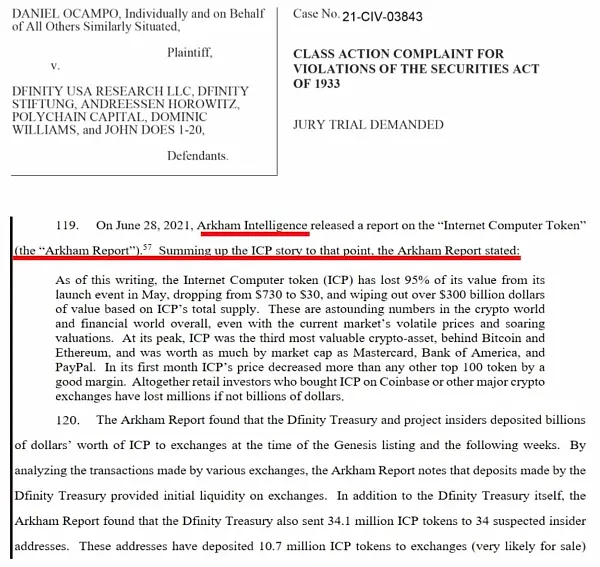
Investigation Summary
As this investigation shows, The New York Times' description of Arkham as a respected "crypto analytics company" has greatly misled crypto enthusiasts. Arkham not only seems to lack the skills necessary to write professional reports, but almost every aspect of the organization is highly suspicious. While the investigation of this case has provided conclusive evidence to the world, even a basic and rough investigation into the organization would indicate that they are untrustworthy, from the strange misaligned dates on their profiles to the complete lack of any historical records about them or their founders on the internet.
Endorsing Arkham and its report in this manner could potentially reduce the market value of the ICP token by billions of dollars. As we have shown, Arkham may have been paid for the report by competitors or those shorting ICP, and the company's main investors are also investing in blockchains that compete with the IC network. While false statements may please clients and satisfy their main investors, the outcome clearly damages the reputation of the IC ecosystem and harms the interests of ICP holders.
Within two weeks of the article's publication, the DFINITY Foundation filed a lawsuit against The New York Times and all team members of Arkham Intelligence in the U.S. District Court for the Southern District of New York, for assault and defamation. Ultimately, the DFINITY Foundation won the case.
